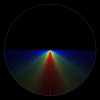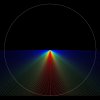That may not be true. If you look at the CIE xy chromaticity for citi 3000K and 2700K I posted a few post ago, it shows very little difference in Deep Blue. The center points of the x and y for both 3000 and 2700 are on the same lateral. If the 3000 had more deep blue than the 2700 the center point would be lower then the 2700. Deep Blue being in the bottom left hand corner.
The CRI 90 chart post on page 1 may be miss leading. The chart is not that great for comparison form one CCT to another. It's intended purpose is the show the relative wavelengths of the single CCT. Each CCT chart is scaled so the highest peak is at 100%. This is most obvious for the 4000K where the blue is the highest peak.
When the PPFD is measured all the wavelengths are summed. This means the width of the peaks is weighs very heavily when calculating PPFD or Lux.
Notice the widths of the higher CCT charts get wider. Yet the peaks at 630nm are all equal. Where is that unaccounted for radiant energy coming from? All these LEDs have the same type and number of dies. But the various CCT variations appear to have significantly different flux energy. That fact along with the CIE xy chromaticity plot indicating the deep blue values are about the same, says to me the charts for each CCT are scaled at different ratios.
This would mean the blue peaks should be about the same height if the curves were scaled at the same ratio. The curves for the 3000K show it has 25% more blue than the 2700K. That 25% is not reflected in the chromaticity plot. It is more likely due to the difference in scaling of the curves.
If you scale down the 3000K by 25%, then the red peak will come came down to about 75% of the 2700K. Then the variation in peak widths will make more sense.
Full disclosure. All of the above is based on my own personal observation and opinion. I believe it to be true because I am really good at this shit. That said, I will also admit I am not normal. Not even close.
A couple of years ago I tasked my self with designing the most efficient LED grow fixture. I have been working with the University of Florida having been hired as a contractor by the professor that leads their LED horticulture research. I have been working on this LED stuff 18 hours a day 7 days a week for the past 2 years.
My decision making process for selecting the 2700K LED is quite different. I bought them to be used as heat sources for thermal experiments. I figured I'd get the best possible PAR CoB so I can use the CLU028-1204 to grow stuff if they survive the thermal experiments. 3 of the 4 that arrived on Monday are still functional.
This week I may have discovered an exceptional method of keeping CoBs running cool. I just bought a milling machine to make some custom parts for the idea.
This is the test setup:
The CoB is mounted on a 0.062" x 1" x 24" copper bar. The copper bar is clamped, using C-Clamps, to a 1/2" copper pipe with water flowing through it.
In this photo, you can see on the multimeter, the thermal pad temperate is 45° C. But this is Florida and this is in my garage and the water temp is rising. Last night I had the thermal pad temperature down to 23° C where ambient was 28° C. Ice cubes in the water.
View attachment 3943776
View attachment 3943784












